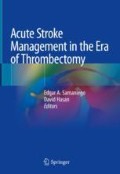Abstract
Stroke is the first cause of disability and the fifth cause of mortality in the United States. In this chapter we discuss the general principles of medical stroke care. The initial goal of the evaluation is to stabilize and assess patient’s eligibility for acute interventions including intravenous tissue plasminogen activator (IV-tPA) and mechanical thrombectomy. That includes a focused history, a standardized examination using National Institute of Health Stroke Scale, and appropriate neuroimaging to rule out intracranial hemorrhage. Once the decision regarding IV-tPA is made, patients should be promptly evaluated for the possibility of a proximal vessel occlusion requiring mechanical thrombectomy. Following any acute interventions, patients should be admitted to a dedicated stroke unit specialized in preventing and monitoring complications. That unit should have the expertise and resources to conduct the necessary investigations to establish the stroke mechanism or subtype in order to implement the most appropriate secondary prevention strategy.
Access this chapter
Tax calculation will be finalised at checkout
Purchases are for personal use only
References
Lackland DT, et al. Factors influencing the decline in stroke mortality: a statement from the American Heart Association/American Stroke Association. Stroke. 2014;45(1):315–53.
Powers WJ, et al. 2018 guidelines for the early management of patients with acute ischemic stroke: a guideline for healthcare professionals from the American Heart Association/American Stroke Association. Stroke. 2018;49(3):e46–e110.
Anderson CS, et al. Cluster-randomized, crossover trial of head positioning in acute stroke. N Engl J Med. 2017;376(25):2437–47.
Brott T, et al. Measurements of acute cerebral infarction: a clinical examination scale. Stroke. 1989;20(7):864–70.
Adams HP Jr, et al. Baseline NIH stroke scale score strongly predicts outcome after stroke: a report of the Trial of Org 10172 in Acute Stroke Treatment (TOAST). Neurology. 1999;53(1):126–31.
Hacke W, et al. Thrombolysis with alteplase 3 to 4.5 hours after acute ischemic stroke. N Engl J Med. 2008;359(13):1317–29.
Wardlaw JM, et al. Thrombolysis for acute ischaemic stroke. Cochrane Database Syst Rev. 2009;4:CD000213.
Tsivgoulis G, et al. Intravenous thrombolysis for ischemic stroke in the golden hour: propensity-matched analysis from the SITS-EAST registry. J Neurol. 2017;264(5):912–20.
Whiteley WN, et al. Risk of intracerebral haemorrhage with alteplase after acute ischaemic stroke: a secondary analysis of an individual patient data meta-analysis. Lancet Neurol. 2016;15(9):925–33.
Demaerschalk BM, et al. Scientific rationale for the inclusion and exclusion criteria for intravenous alteplase in acute ischemic stroke: a statement for healthcare professionals from the American Heart Association/American Stroke Association. Stroke. 2016;47(2):581–641.
Yeatts SD, et al. Alteplase for the treatment of acute ischemic stroke in patients with low National Institutes of Health stroke scale and not clearly disabling deficits (potential of rtPA for ischemic strokes with mild symptoms PRISMS): rationale and design. Int J Stroke. 2018;13(6):654–61. https://doi.org/10.1177/1747493018765269.
Fugate JE, Rabinstein AA. Absolute and relative contraindications to IV rt-PA for acute ischemic stroke. Neurohospitalist. 2015;5(3):110–21.
Nogueira RG, et al. Thrombectomy 6 to 24 hours after stroke with a mismatch between deficit and infarct. N Engl J Med. 2018;378(1):11–21.
Albers GW, et al. Thrombectomy for stroke at 6 to 16 hours with selection by perfusion imaging. N Engl J Med. 2018;378(8):708–18.
Vidale S, Agostoni E. Prehospital stroke scales and large vessel occlusion: a systematic review. Acta Neurol Scand. 2018;138(1):24–31.
Fiorelli M, et al. Hemorrhagic transformation within 36 hours of a cerebral infarct: relationships with early clinical deterioration and 3-month outcome in the European Cooperative Acute Stroke Study I (ECASS I) cohort. Stroke. 1999;30(11):2280–4.
Stroke Unit Trialists, C. Organised inpatient (stroke unit) care for stroke. Cochrane Database Syst Rev. 2013;11(9):CD000197.
Gray CS, et al. Glucose-potassium-insulin infusions in the management of post-stroke hyperglycaemia: the UK glucose insulin in stroke trial (GIST-UK). Lancet Neurol. 2007;6(5):397–406.
Vahedi K, et al. Early decompressive surgery in malignant infarction of the middle cerebral artery: a pooled analysis of three randomised controlled trials. Lancet Neurol. 2007;6(3):215–22.
Juttler E, et al. Hemicraniectomy in older patients with extensive middle-cerebral-artery stroke. N Engl J Med. 2014;370(12):1091–100.
Mostofi K. Neurosurgical management of massive cerebellar infarct outcome in 53 patients. Surg Neurol Int. 2013;4:28.
Agarwalla PK, Stapleton CJ, Ogilvy CS. Craniectomy in acute ischemic stroke. Neurosurgery. 2014;74(Suppl 1):S151–62.
Dennis M, et al. FOOD: a multicentre randomised trial evaluating feeding policies in patients admitted to hospital with a recent stroke. Health Technol Assess. 2006;10(2): p. iii–iv, ix–x, 1–120.
Shorr AF, et al. Differences between low-molecular-weight and unfractionated heparin for venous thromboembolism prevention following ischemic stroke: a metaanalysis. Chest. 2008;133(1):149–55.
Chamorro A, et al. The early systemic prophylaxis of infection after stroke study: a randomized clinical trial. Stroke. 2005;36(7):1495–500.
Chollet F, et al. Fluoxetine for motor recovery after acute ischaemic stroke (FLAME): a randomised placebo-controlled trial. Lancet Neurol. 2011;10(2):123–30.
Adams HP Jr, et al. Classification of subtype of acute ischemic stroke. Definitions for use in a multicenter clinical trial. TOAST. Trial of Org 10172 in Acute Stroke Treatment. Stroke. 1993;24(1):35–41.
De Rango P, et al. Summary of evidence on early carotid intervention for recently symptomatic stenosis based on meta-analysis of current risks. Stroke. 2015;46(12):3423–36.
Barkat M, et al. Systematic review and network meta-analysis of treatment strategies for asymptomatic carotid disease. Sci Rep. 2018;8(1):4458.
Chimowitz MI, et al. Stenting versus aggressive medical therapy for intracranial arterial stenosis. N Engl J Med. 2011;365(11):993–1003.
Gladstone DJ, et al. Atrial fibrillation in patients with cryptogenic stroke. N Engl J Med. 2014;370(26):2467–77.
Mas JL, et al. Patent foramen Ovale closure or anticoagulation vs. Antiplatelets after stroke. N Engl J Med. 2017;377(11):1011–21.
AVERT Trial Collaboration group. Efficacy and safety of very early mobilisation within 24 h of stroke onset (AVERT): a randomised controlled trial. Lancet. 2015;386(9988):46–55.
Author information
Authors and Affiliations
Corresponding author
Editor information
Editors and Affiliations
Rights and permissions
Copyright information
© 2019 Springer Nature Switzerland AG
About this chapter
Cite this chapter
Shaban, A., Leira, E.C. (2019). Best Medical Management for Acute Ischemic Stroke. In: Samaniego, E., Hasan, D. (eds) Acute Stroke Management in the Era of Thrombectomy. Springer, Cham. https://doi.org/10.1007/978-3-030-17535-1_1
Download citation
DOI: https://doi.org/10.1007/978-3-030-17535-1_1
Published:
Publisher Name: Springer, Cham
Print ISBN: 978-3-030-17534-4
Online ISBN: 978-3-030-17535-1
eBook Packages: MedicineMedicine (R0)

